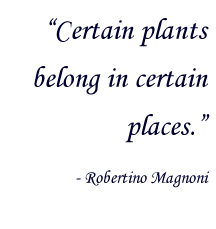Robertino Magnoni: Flowers for Cagli
by Molly Rupert
Robertino “Roberto” Magnoni flips furiously through the pages of one of the many seed catalogs piled on his desk until he finds just the right picture. “This one,” he says in Italian through an interpreter, and then points to a beautiful, hot-pink flower.
He flips the pages again, more slowly now. “And this one is the most precious,” he says, pointing to a pretty Margarita poesy. The flowers on the pages aren’t often seen in Cagli, Italy, but Roberto hopes to change that.
“Certain plants belong in certain places,” he says. “I like flower plants, not vegetables.”
Roberto says the flowers will grow well in Le Marche region, so he started a new business specializing in flowers for the area. The flowers and business are doing well, so well, in fact, that as soon as he’s given permission from the city, he will move into his own business and growing space. For now, Roberto, 44, runs an Internet business, grows flowers at his uncle’s nursery, and caters to wholesale shops and landscape architects with his special-order flowers. His business is called Vivaio La Rosa Profumata.
Like many business owners, Roberto plans ahead. He has already ordered more than 200 Aquilegias in four different varieties, as well as three varieties of Arabis and both white and rose-colored Armerias. Aquilegia is the Italian name for Columbine and comes in a wide range of colors including red, pink, cream, and violet. The Arabis plants have hairy, lobed leaves with small, white flowers. The Armerias are sun-loving, low-growing evergreen plants.
The seed packets will arrive in time for the next spring planting season. The seeds come from all over Europe and are ordered weekly. Roberto also has roses, bamboo, hydrangeas, and a wide variety of other plants and trees for his customers who want something different.
A Cagli “thoroughbred” or native, Roberto learned about plants when he built and maintained forest trails between France and Italy. Following a family emergency, Roberto says, he returned to help his Uncle Quinto with the family nursery. That was 15 years ago.
Roberto found his own niche in the nursery world when a local friend and business associate suggested Roberto order different varieties of flowers not often found in Cagli nurseries. The friend wanted something specific. “This landscape architect drove me nuts until he got what he wanted,” Roberto says of the special-order flowers. That was when he realized that he could start a different type of nursery that featured special plants gardeners in the area would like.
 “The landscape architect told me what I should grow,” Roberto says. So he began to read and study. He took horticulture classes to learn more. He spent time determining which plants like the shade and which the sun. He added herbs to his stock for kitchen gardens.
“The landscape architect told me what I should grow,” Roberto says. So he began to read and study. He took horticulture classes to learn more. He spent time determining which plants like the shade and which the sun. He added herbs to his stock for kitchen gardens.
“The spice-and-herb garden has to be close to the kitchen,” Roberto says.
As for flowers, among Roberto’s favorites is the Margarita, which he says produces lots of small, white flowers that look a lot like a daisy. They also come in other colors and are Roberto’s best sellers.
When the seeds first arrive, Roberto runs them through a seed-sowing machine that separates the tiny seeds into small, round troughs. After they grow big enough, the seedlings are transplanted using a potting machine that mixes manure and potting soil as a base for each new plant. The seeds and dirt mixture go into small, 4-inch pots and then onto a conveyor belt. The new seedlings are sorted by plant type and variation.
Roberto waters and nurtures them in a large, domed tent until they are ready to go outside. The flowers and plants wait outside until they are ready to be planted. An organized grid system keeps similar plants together so it’s easy to find what his client wants. This takes more than just the average eight-hour day.
“I work from 8 a.m. to dark,” he says.
In the summer, there aren’t enough hours to get all his work done. He digs ditches for irrigation, pulls weeds and plants flowers. In winter, the outside manual labor lightens slightly, and Roberto continues planning for the next planting season. But it isn’t just the flowers that interest Roberto. He is fascinated by the irrigation systems that help keep the plants alive. He works with an American supplier and has the parts for irrigation systems shipped here for his clients. So far, the largest irrigation system he built was in Pesaro and covers more than 2,000 square-meters of grass, garden and trees.
With all his knowledge of plants and gardens, Roberto has one piece of advice for fellow flower lovers: “Remember, the dog is the worst enemy of the garden.”
Visit www.larosaprofumata.com for more information.
Adventure with Us!








